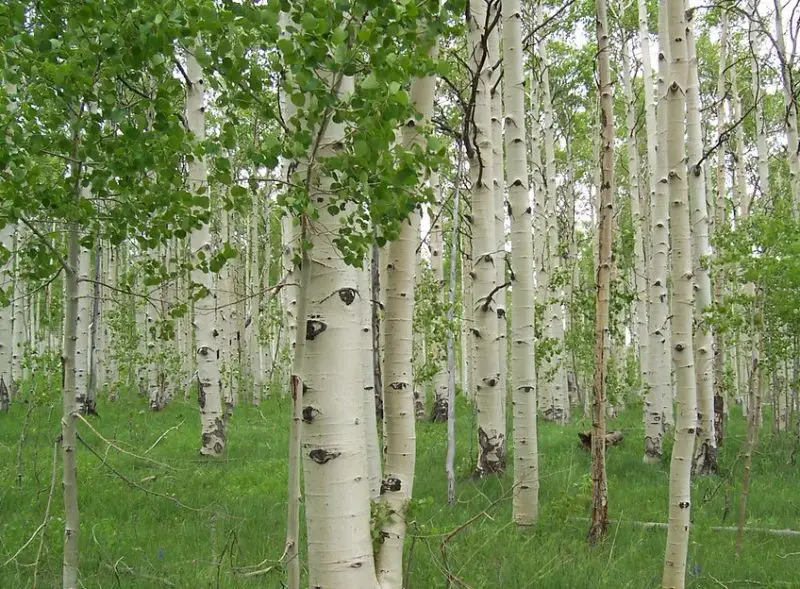Quaking Aspen (Populus tremuloides) is a beautiful and fast-growing deciduous tree known for its vibrant yellow fall foliage and distinctive trembling leaves. It is native to North America and thrives in various climates and soil conditions.
This guide will provide detailed information on how to successfully grow and care for Quaking Aspen trees.
Characteristics of Quaking Aspen

Appearance
Quaking Aspen (Populus tremuloides) is a medium-sized deciduous tree known for its striking visual appeal and adaptability. It typically grows to a height of 20 to 50 feet, although in ideal conditions, some specimens can reach up to 80 feet tall. The tree’s canopy spreads between 20 and 30 feet, forming an open, airy crown that allows sunlight to filter through.
One of the most recognizable features of the Quaking Aspen is its foliage. The leaves are small, nearly round, and have finely serrated edges. During the summer months, they display a vibrant green hue, creating a lush canopy that trembles with the slightest breeze—hence the name “quaking.” In autumn, the leaves turn a brilliant golden-yellow, forming spectacular fall landscapes before shedding for the winter.
The bark of a young Quaking Aspen is smooth and pale white, occasionally displaying a slightly greenish tint due to the presence of chlorophyll. As the tree matures, black knots and scars form on the bark, creating a visually distinctive pattern. These markings result from natural growth, environmental stressors, or past branches that have fallen off.
Beneath the surface, Quaking Aspen possesses an extensive root system that spreads aggressively. This underground network enables the tree to reproduce through root suckers, allowing new shoots to emerge and establish themselves nearby. Over time, this propagation method leads to the formation of dense groves, often consisting of genetically identical trees connected through the same root system.
Growth Rate
Quaking Aspen is a fast-growing tree, capable of adding between 2 to 3 feet in height per year when provided with favorable conditions. Its rapid growth is largely supported by its ability to propagate through root suckers. Rather than relying solely on seed germination, new shoots sprout from the roots of an established tree, ensuring continuous expansion. This clonal reproduction allows Quaking Aspen to quickly colonize open areas, making it a dominant species in many North American forests.
Hardiness Zone
Thriving in a range of environmental conditions, Quaking Aspen is well-suited to USDA hardiness zones 1 through 7. It is highly adaptable to cold climates and is commonly found at high altitudes, where other tree species may struggle to survive. Its tolerance for extreme temperatures and diverse soil conditions contributes to its widespread presence across North America, from the boreal forests of Canada to the mountainous regions of the western United States.
How to Grow Quaking Aspen
Choosing the Right Location
Selecting an ideal planting site is crucial for the health and longevity of Quaking Aspen trees. These trees thrive in full sunlight, requiring at least six hours of direct sunlight per day to ensure strong growth and vibrant foliage. They are well-suited for open landscapes where they can receive unobstructed light, making them excellent choices for meadows, large yards, and naturalized areas.
In terms of soil preference, Quaking Aspen performs best in well-drained soils that prevent water from pooling around the roots. While the tree is highly adaptable and can grow in a variety of soil types, loamy or sandy soils provide the optimal conditions for healthy root development. These soil textures allow for proper aeration and moisture retention without becoming overly compacted, ensuring steady growth.
Soil pH also plays a role in the tree’s success. Quaking Aspen prefers slightly acidic to neutral soil, with an ideal pH range between 5.5 and 7.5. Maintaining the correct pH helps the tree efficiently absorb essential nutrients, promoting lush foliage and overall vitality. If necessary, soil amendments such as organic matter or lime can be used to adjust the pH to suitable levels.
Another important factor to consider when choosing a location is air circulation. Quaking Aspen thrives in open areas where the movement of air helps reduce humidity around the foliage, decreasing the risk of fungal diseases such as leaf spot and cankers. Avoid planting in overly crowded or enclosed spaces, as limited airflow can create a more favorable environment for pests and diseases to take hold.
Planting Instructions
Proper planting is essential to help Quaking Aspen establish strong roots and thrive in its new environment. Following these steps will give the tree the best start and promote healthy growth.
1. Select a Healthy Sapling
Begin by choosing a young tree with a well-developed root system. Look for a sapling with a straight, sturdy trunk and vibrant, disease-free leaves. If purchasing from a nursery, inspect the root ball to ensure it is moist and not root-bound, meaning the roots should not be tightly circling the container. A healthy sapling will adapt more quickly to transplanting and establish itself with minimal stress.
2. Dig a Proper Hole
Prepare the planting site by digging a hole that is twice as wide as the root ball and equal in depth. A wider hole allows the roots to spread more easily, while maintaining the same depth ensures that the tree is planted at its original soil level. Avoid digging too deep, as this can lead to improper root establishment and potential issues with stability.
3. Position the Tree Correctly
Carefully place the sapling in the hole, making sure it stands upright and straight. Spread the roots evenly, ensuring they are not bunched up or twisted. If the roots have grown in a circular pattern inside the container, gently loosen them before placing the tree in the hole to encourage outward growth.
4. Backfill with Soil
Gradually fill the hole with the excavated soil, gently firming it around the roots as you go. Lightly press the soil to eliminate air pockets, which can cause root drying and instability. However, avoid compacting the soil too much, as this can hinder root expansion and water penetration. If the soil is particularly poor or heavy, consider mixing in compost or organic matter to improve drainage and nutrient availability.
5. Water Thoroughly
Once the tree is in place, give it a deep, thorough watering to help settle the soil and provide initial moisture for the roots. The goal is to keep the soil evenly moist but not waterlogged. In the first few weeks after planting, monitor the moisture levels closely, especially during dry periods, to ensure the young tree does not dry out.
6. Apply a Layer of Mulch
To help retain soil moisture and regulate temperature, apply a 2-inch layer of organic mulch, such as wood chips or shredded bark, around the base of the tree. Spread the mulch in a wide circle, keeping it a few inches away from the trunk to prevent rot and discourage pests. Mulching also helps suppress weeds, reducing competition for nutrients and water.
Spacing Considerations
When planting multiple Quaking Aspen trees, it is essential to provide adequate space between them to ensure healthy growth and prevent overcrowding. These trees should be spaced at least 15 to 20 feet apart to allow for proper root expansion, canopy development, and airflow.
Allowing for Root Expansion
Quaking Aspen has an extensive root system that spreads aggressively underground. If trees are planted too closely together, their roots will compete for water and nutrients, which can hinder growth and weaken the trees over time. Providing sufficient space allows each tree’s root system to establish itself without excessive competition, promoting healthier and more resilient growth.
Encouraging Healthy Canopy Development
As Quaking Aspens mature, their branches spread outward, forming a dense canopy. If planted too close together, their crowns may become crowded, limiting sunlight penetration and airflow. Proper spacing ensures that each tree receives enough light, which is essential for photosynthesis and vibrant foliage, especially during the fall when their golden-yellow leaves create stunning landscapes.
Preventing Disease and Pest Issues
Good spacing also reduces the risk of fungal diseases and pest infestations. When trees are planted too close, moisture can become trapped between them, creating a humid environment that promotes the spread of diseases like leaf spot and cankers. Adequate spacing improves air circulation, helping to keep the foliage dry and minimizing the risk of infection.
Planning for Clonal Growth
Quaking Aspen naturally propagates through root suckers, forming large groves over time. If a single tree is planted, it may eventually produce genetically identical offshoots nearby. When planting multiple trees, it’s important to consider this natural expansion and leave enough room for new shoots to emerge without overcrowding the existing trees.
Quaking Aspen Care Guide
Proper care ensures that Quaking Aspen trees remain healthy, vibrant, and resilient. By following the guidelines below, you can help your tree thrive in a variety of environments.
Watering Needs
Young Quaking Aspen trees require consistent moisture to establish a strong root system. During the first few years after planting, water deeply once or twice a week, ensuring the soil remains evenly moist but not waterlogged. The frequency may need to increase during hot or dry periods, especially in sandy soils that drain quickly.
Once established, mature Quaking Aspens develop greater drought tolerance and can survive on natural rainfall. However, they benefit from deep watering during prolonged dry spells, particularly in regions with little summer precipitation. A slow, deep soak every few weeks will encourage strong root growth and help the tree remain healthy.
Overwatering should be avoided, as excessive moisture can lead to root rot, fungal diseases, and poor oxygen circulation in the soil. Ensure that the planting site drains well and does not become waterlogged after heavy rains.
Soil Requirements
Quaking Aspen thrives in well-drained sandy or loamy soil that allows proper aeration and prevents excessive water retention. These soil types promote deep root penetration and create an ideal growing environment.
Heavy clay soils, which hold too much moisture, should be avoided as they can lead to root suffocation and disease. If planting in less-than-ideal soil, incorporating compost, organic matter, or sand can improve drainage and nutrient availability.
A slightly acidic to neutral soil pH (5.5 to 7.5) is preferred. Conducting a soil test before planting can help determine if any amendments are needed to optimize the growing conditions.
Sunlight Requirements
Full sunlight is essential for the healthy development of Quaking Aspen. The tree requires at least six hours of direct sunlight per day to produce strong, well-formed branches and vibrant foliage.
Planting in shaded or partially shaded areas can result in weakened trunks, sparse foliage, and increased susceptibility to disease. In areas where trees are grown closely together, proper spacing helps ensure that each tree receives sufficient sunlight for optimal growth.
Fertilization
Applying fertilizer can enhance the tree’s growth and overall health, particularly in nutrient-poor soils. Use a balanced fertilizer with a ratio of 10-10-10 (nitrogen, phosphorus, and potassium) in early spring to support strong root and leaf development.
Excessive nitrogen should be avoided, as it can encourage weak, overly rapid growth that makes the tree more vulnerable to wind damage and disease. Instead of relying solely on chemical fertilizers, incorporating organic compost around the base of the tree can naturally improve soil fertility and structure over time.
Pruning and Maintenance
Regular pruning helps maintain the health and appearance of Quaking Aspen trees. Annual pruning is recommended to remove dead, damaged, or diseased branches, preventing the spread of infections and improving the tree’s structure.
Thinning out overcrowded growth encourages better air circulation, reducing the risk of fungal diseases. This is particularly important in groves or areas where multiple trees are planted close together.
For best results, pruning should be done during late winter or early spring, before new growth begins. This timing minimizes stress on the tree and reduces the likelihood of attracting pests or infections through open wounds.
Common Issues and Solutions
While Quaking Aspen trees are hardy and adaptable, they can be affected by pests, diseases, and their natural tendency to spread through root suckers. Proper management and preventive care can help keep the trees healthy and thriving.
Pests
Several insects can affect Quaking Aspens, causing damage to leaves, bark, and overall tree health. Identifying and addressing pest issues early can prevent more severe infestations.
- Aspen Leaf Miners – These small insects tunnel inside leaves, creating distinctive serpentine trails that can reduce photosynthesis and weaken the tree. While leaf miners rarely cause severe damage, they can affect the tree’s appearance. Solution: Apply insecticidal soap or neem oil to infested leaves, particularly in the early stages of an infestation. Removing and disposing of affected leaves can also help reduce their spread.
- Aphids – These tiny, sap-sucking insects cluster on leaves and stems, causing leaf curling and reducing tree vigor. They also secrete honeydew, which can lead to sooty mold growth. Solution: Introduce natural predators like ladybugs or lacewings to help control aphid populations. Alternatively, spray horticultural oils or a mild soap solution to eliminate them.
- Borers – Aspen bark beetles and other wood-boring insects can tunnel into the trunk and branches, weakening the tree and making it susceptible to disease. Solution: The best prevention is maintaining overall tree health through proper watering, fertilization, and pruning. Stressed or weakened trees are more likely to attract borers, so avoiding damage to the bark and roots can also help reduce infestations.
Diseases
Fungal and bacterial infections can affect Quaking Aspen, leading to issues such as leaf discoloration, bark lesions, and premature leaf drop.
- Cytospora Canker – This fungal disease causes dark, sunken lesions on the bark, leading to branch dieback and overall decline. It often affects trees that are stressed due to drought, poor soil, or injury. Solution: Prune and dispose of infected branches to prevent the disease from spreading. Improving tree health by providing adequate water, nutrients, and airflow can enhance resistance to infection.
- Rust Fungi – A fungal disease that appears as bright orange spores on leaves, leading to premature leaf drop and reduced photosynthesis. Rust infections often spread in humid, crowded conditions. Solution: Remove and destroy affected leaves to reduce the spread of spores. Ensure proper spacing and prune excess branches to improve air circulation.
- Leaf Spot Diseases – Caused by various fungi, these infections produce dark or black spots on leaves, sometimes leading to premature defoliation. Wet and humid conditions can encourage their development. Solution: If the infection is severe, apply a fungicide to affected trees. Removing and discarding fallen leaves in autumn can help prevent reinfection the following season.
Root Suckers
One of the defining characteristics of Quaking Aspen is its ability to spread through root suckers. While this allows the tree to form natural groves, it can also lead to excessive sprouting in unwanted areas.
To manage root suckers effectively:
- Regularly mow or prune unwanted shoots – Cutting down young suckers as they appear prevents them from developing into mature trees.
- Use physical barriers around the root zone – Installing root barriers made of plastic or metal can help contain underground spread and limit the emergence of new shoots.
Benefits of Growing Quaking Aspen
Quaking Aspen is not only a beautiful addition to any landscape but also provides numerous environmental and practical benefits. From supporting wildlife to enhancing aesthetics and offering valuable timber resources, these trees serve multiple purposes in both natural and cultivated settings.
Environmental Benefits
Quaking Aspen plays a vital role in supporting ecosystems. Its foliage, bark, and seeds provide essential food and shelter for a wide range of wildlife, including birds, deer, and small mammals. Many species rely on Aspen groves for nesting sites and protection from predators. Additionally, these trees contribute to soil stabilization, as their extensive root systems help anchor the ground, reducing the risk of erosion, particularly on slopes and in areas prone to soil degradation.
Another crucial environmental benefit of Quaking Aspen is its ability to improve air quality. Like all trees, it absorbs carbon dioxide from the atmosphere, helping to mitigate climate change. By filtering pollutants and releasing oxygen, it contributes to cleaner, fresher air, making it an excellent choice for both urban and rural planting.
Aesthetic Value
One of the most striking features of Quaking Aspen is its brilliant fall foliage. As the seasons change, the tree’s round, fluttering leaves turn vibrant shades of yellow and gold, creating breathtaking autumn landscapes. The contrast between its smooth, white bark and colorful leaves adds visual appeal throughout the year, even in winter when the bare trunks stand out against the snow.
In addition to its seasonal beauty, Quaking Aspen serves practical landscaping purposes. When planted in rows or clusters, it functions as a natural windbreak, reducing wind speed and providing shelter for homes, gardens, and other vegetation. Its dense growth also makes it an excellent choice for privacy screens, offering seclusion while maintaining a natural, picturesque look.
Timber and Wood Uses
Beyond its ornamental and ecological value, Quaking Aspen has significant economic importance. Its lightweight yet durable wood is widely used in the production of paper, plywood, and engineered wood products. Due to its fine texture and ease of processing, it is also a preferred material for making furniture, crates, and matches.
The tree’s versatility makes it valuable in various industries, and because Aspen regenerates quickly through its root system, it is considered a sustainable wood source. This rapid growth and ability to form dense groves make it an excellent option for reforestation and commercial timber harvesting without the need for replanting.
Conclusion
Quaking Aspen (Populus tremuloides) is a beautiful and fast-growing tree that adds charm to any landscape. With proper care, including adequate watering, pruning, and pest control, it can thrive for decades. Whether you plant it for its aesthetic appeal or environmental benefits, this tree is a valuable addition to gardens and natural spaces.






